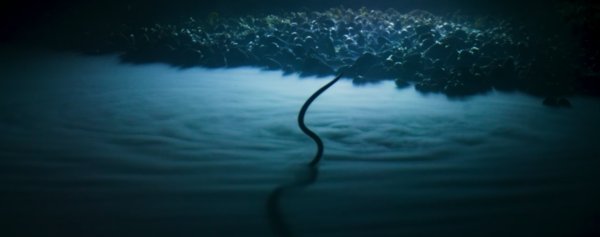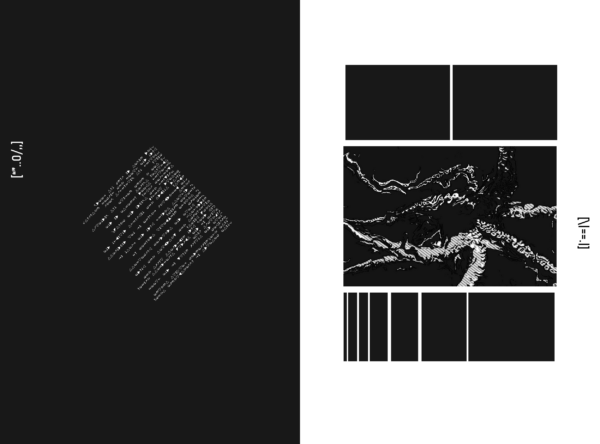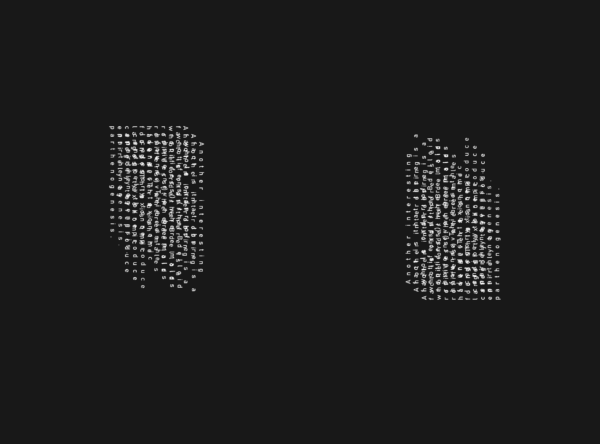
In “The Deep,” the second episode of BBC’s nature documentary series Blue Planet II, host David Attenborough narrates the journey of a deep ocean submersible as it travels to the ocean floor near Antarctica. Along its descent, we are treated to dramatic, violent, and bizarre scenes that seem more akin to an alien planet in a work of science fiction than our world. In the uncharted depths, the submersible encounters giant bioluminescent pyrosomes, swarms of hunting Humboldt squid, and long dripping tails of siphonophores, colonies of clonal marine organisms living “beyond the normal rules of time.” Upon reaching the sea floor, the submersible captures an incredibly abject feeding session as a shiver of sharks shreds the rotting carcass of a whale. The viewer becomes lost in a furious orgy of gnashing jaws and blood. Despite all of the deep ocean’s spectral beauty, the horror of death and decay permeate the waters.
This is the abyssal zone, or “the twilight zone…a sea of eternal gloom.” Dodging plumes of rising methane, the submersible comes upon an amazing fluke of nature: a lake of concentrated salt water at the bottom of the sea, extending out like a strange void within the void. The submersible analyzes the surprising “profusion of life” around its margin. The most compelling denizens of this lake-within-the-sea are cutthroat eels, scavengers that occasionally venture into the briny lake in search of food. An eel, eerily backlit by the submersible’s lights, slithers and darts into the lake, disappearing beneath the hazy surface. Upon emerging, the eel writhes in pain, mouth agape, tying itself into knots and figure-eights. As it jerks and spasms, Attenborough explains that spending too long within the lake can send the eels into toxic shock. The eel overcomes the shock, but the camera turns to the embalmed bodies of other deep sea creatures who succumbed to the toxic salinity and pressure of the undersea lake.
The twitching cutthroat eel, curled into a knot of suffering, blind and desperate for survival, is an affective image. It is dark and disturbing, but also poetic, almost primitively so. In his new book of poetry, ZER000 EXCESS (11:11 Press, 2020), Jake Reber’s language writhes like the cutthroat eel at the bottom of the sea. In a post-conceptual mode that shirks traditional readability for graphic and aesthetic elements, Reber concocts a frightening, post-anthropocenic language space where technological terminology, pure transcription, and science fiction/horror tropes unite in a slurry of decayed meaning. Throughout the text, Reber ventures into the abyssal zone of language, replicating the behaviors of deep sea creatures (swarming, isolating, camouflaging) and the deep ocean itself (pressure, decay, opacity) through his poetics.

Reber’s book is better understood as a text-object than a collection of poems; its graphic and typographic elements often overwhelm the language within. The book alternates between black and white pages, which further dissembles and disrupts expectations. In fact, the book recalls a graphic novel in basic appearance. Warped and rippling black-and-white images permeate its pages. These heavily processed images, laden with digital effects, dance the line of legibility alongside the text. Fragments of recognizable imagery (octopus tentacles, the pupil of an eye) are blown out in psychedelic glitch art, gnawing the edges of pages and eclipsing blocks of white text. The graphics present virally, or like a slime mold: spreading rapidly throughout, morphing and mutating the language of the book, oftentimes overtaking words and stanzas in visual importance. Clearly, the text of this book is the least interesting element of it, which makes for an exciting book of poetry. The poetics of ZER000 EXCESS are instead mainly articulated through elements of arrangement, juxtaposition, and visual translation. As though seen through the compound eye of an abyssal sea creature, the reader must filter the text as a whole to fully absorb it.
The book is split into six sections, with titles including “[embryonic biocosmic war]” and “[dead archives].” Lines of poems are broken up with typographic symbols, such as slashes and brackets. Blocks of text are printed over one another, or warped with effects that liquefy or gel the text into blurs. All of these design choices give the already fragmentary text a sense of movement: surging and spiraling at times, and at other moments drifting apart in the doldrums of a black page. Structural patterns emerge and are broken; amongst all of the chaos some ‘characters’ appear, such as Ada, a genderless character trapped in a dystopian sci-fi panopticon screen hell, and more conceptual entities, like the Splicer and Capital Lamprey, whose presence bends the text around them. The tone of the poems is often devoid of emotion and urgency, mirroring the coolness of technological communication, despite the subject matter, which includes images seemingly pulled from body horror films
embryonic bioids
delaminate from
the membrane
displaced
outwards
Undergoing
multiple stages
of differentiation
Until — the
stratum
losing and fusing
sheets
eventually shed
from the surface
(desquamation).
differentiated
wetware form
extracellular
matrix
Integration
deep skin barrier
function.
These poems break down in the surrounding pressure, and origin and meaning get obscured in the transmogrifying decay. On other pages, the text is completely lost, instead rendered in the Wingdings 3 font: squares of blocky cartoon arrows flowing like cilia or anemone, mutely gesturing in some other, inaccessible communication.
ZER000 EXCESS is a work of “ambient body horror.” While its lack of linearity and other aspects may reflect compositional sensibilities from ambient or drone music, the chaotic sampling, fractured typography, and engagement with illegibility are common characteristics of the noise music genre (an intentionally open-ended and interpretive label). As Michel Serres writes in Genesis, his study of noise: “Background noise is the ground of our perception, absolutely uninterrupted, it is our perennial sustenance, the element of the software of all our logic. It is the residue and the cesspool of our messages.”[1] The cesspool — or primordial soup vent? Reber blends the noise of protean darkness with his cryptic images and fragmented technical language, including deteriorated chunks of Wikipedia entries that read like decayed carcasses amassed in the muddy abyss. What emerges is a scavenger text, or a reading experience gathered from the flotsam of the anthropocene. Uniting the moments of decomposition and engorgement is the background noise of darkness accompanying the text. Pulsating from ink of word to ink of graphic, the text propulses itself through the pages like a squid on an ink jet, traversing a sonic landscape of “a thousand slack algaes at the bottom of the sea.”[2]
Another framework for Reber’s text is that of the “swarm.” As Blue Planet II deftly depicts, aquatic lifeforms often swarm together, for protection against predators, to hunt for food, and to procreate. Swarming is a major characteristic of survival for anything from seals to cephalopods to bottom-feeder crustaceans. In Insect Media, Jussi Parikka writes: “Swarm intelligence characterizes computer science algorithms, multi-agent systems, and insects.”[3] Reber’s methods of composition mirror these intelligences, and his probing of their systems produces generative compositions. The sections of ZER000 EXCESS echo one another in certain ways, while also sedimenting their at times difficult syntactic idiosyncrasies. For Parikka, the swarm as “a biophilosophy also suggests a new way of understanding materiality not based on a substance or form but as a temporal variation of affective assemblages.”[4] Reber’s poetics evolve and devolve in unicellular variations. Images rotate and pixelate between slabs of junk code; origin becomes inert. What further “flock object collectivities” and “sensing algorithms” can we use to create digitally-conscious poetics? What could such compositions do over deep time, stretching out endlessly in their abyssal recreations?

This suffocative environment, pressurized and cramped with frames of concept-art cnidarian waveforms, articulates its own anxieties. In one of the final sections of the book, a text-within-the-text appears, a page-for-page “dead archive,” a captured submersible overview of pdf files. Equally further in, Reber frustratedly ponders the digital detritus that has come to define our age of informational overload.
DEATH TO THE (MOTHERFUCKING) ARCHIVE LONG LIVE THE
ARCHIVEPools of dead-data ///// deadbook & such
Mutation and metallic lust surge electric slime ///// nonhuman in
the active internet. Humans are no longer operating the control
codes:the internet is now over 50% nonhuman traffic
Lost in the realm of replication, one can imagine the contents of our desktop Trash bins slowly descending into the murky passages of an endless junkpile: the digital realm. Through our accumulation, our archives, our symbols, our capital, Reber reminds us that
digital decay was all we
needed ///// perpetual click
and watch death disappear
/////
either in material
fragmentation and rot /////or
becoming completely
subsumed by the data glut,/////
never reemerging.
To collapse informational waste into ecological waste is to better understand the human propensity for litter, for refuse. To build language from digital detritus is to better envision ways of translating survival in a damaged world. Or, to paraphrase Serres, a complex is always a simplex. Reber scans and recreates the abyssal language system of our time into a malfunctioning diorama of bionecropower.
How can venturing into the darkest depths of our language space teach us about our roles in greater, sometimes sinister, forces? Will we survive to continue our wandering, scuttling across the floors of silent seas? Will we thrash like the toxified cutthroat eel? ZER000 EXCESS may leave the reader tying themselves into knots, but as a glimpse into the lake-within-the-sea of language, perhaps this is Reber’s intended condition. In the enervated world below our current depths, we are confronted with an equally exciting and terrifying glimpse into a chthonic deep future.
________________________
[1] Michel Serres, Genesis (trans. Geneviève James and James Nielsen). University of Michigan Press, 1995.
[2] Ibid.
[3] Jussi Parikka, Insect Media: An Archeology of Animals and Technology. University of Minnesota Press, 2010.
[4] Ibid.